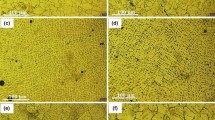Abstract
This paper discusses the effect of different combinations of preheating and post-heating on the corrosion and hydrogen embrittlement of Grade-91 steel weld joint in the as-welded condition. Though these welds are subjected to post-weld heat treatment (PWHT), there could be long delay in executing this, especially in the case of fabrication of large components, and during this delay, the welds in as-welded conditions are prone to environmental degradations like hydrogen embrittlement and different forms of corrosion. Though recommended minimum preheating and post-heating conditions are already known for welding of this class of steels, marginally increasing the temperature of preheating and post-heating or increasing the duration of post-heating can permit longer delay in the post-weld heat treatment (PWHT), without increasing the risk of environmental degradation. With this objective, a set of thirteen single-V multi-pass gas tungsten arc weld joints of Grade-91 steel fabricated with different preheating and post-heating combinations. Results indicated a significant reduction in residual tensile stresses in the weld metal and reversing into compressive stresses upon preheating and post-heating at 300 °C. Moreover, diffusible hydrogen content and corrosion rate decreased significantly with the preheating and post-heating. However, there are no significant variations in the microstructure, mechanical properties, and hydrogen embrittlement with preheating and post-heating. This study proved that the risk of embrittlement in Grade-91 steel welds due to an indefinite delay in PWHT could be minimized by combined preheating and post-heating.









Similar content being viewed by others
References
Pandey C, Mahapatra MM, Kumar P, Saini N, Srivastava A (2017) Microstructure and mechanical property relationship for different heat treatment and hydrogen level in multi-pass welded P91 steel joint. J Manuf Process 28:220–234
Bhaduri AK, Laha K, Ganesan V, Sakthivel T, Nandagopal M, Reddy GP, Kumar JG, Vijayanand VD, Selvi SP, Srinivasan G, Das CR (2016) Advanced materials for structural components of Indian sodium-cooled fast reactors. Int J Press Vessel Pip 139:123–136
Pai A, Sogalad I, Albert SK, Kumar P, Mitra TK, Basavarajappa S (2014) Comparison of microstructure and properties of modified 9Cr-1Mo welds produced by narrow gap hot wire and cold wire gas tungsten arc welding processes. Prog Mater Sci 5:1482–1491
Dey HC, Albert SK, Bhaduri AK, Roy GG, Balakrishnan R, Panneerselvi R (2014) Effect of post-weld heat treatment (PWHT) time and multiple PWHT on mechanical properties of multi-pass TIG weld joints of modified 9Cr-1Mo steel. Weld World 58:389–395
Swindeman RW, Santella ML, Maziasz PJ, Roberts BW, Coleman K (2004) Issues in replacing Cr–Mo steels and stainless steels with 9Cr–1Mo–V steel. Int J Press Vessel Pip 81:507–512
Pandey C, Mahapatra MM, Kumar P (2018) Effect of post weld heat treatments on fracture frontier and type IV cracking nature of the crept P91 welded sample. Mat Sci Eng A 731:249–265
Arivazhagan B, Sundaresan S, Kamaraj M (2009) A study on influence of shielding gas composition on toughness of flux-cored arc weld of modified 9Cr–1Mo (P91) steel. J Mater Process Technol 209:5245–5253
Pai A, Sogalad I, Basavarajappa S, Kumar P (2019) Results of tensile, hardness and bend tests of modified 9Cr 1Mo steel welds: comparison between cold wire and hot wire gas tungsten arc welding (GTAW) processes. Int J Press Vessel Pip 169:125–141
Kou S (2003) Welding metallurgy. New Jersey, USA. 431-46.
Dayal RK, Parvathavarthini N (2003) Hydrogen embrittlement in power plant steels. Sadhana. 28:431–451
(2007) Private communication between M/s BHAVINI customer for PFBR and supplier of PFBR steam generators.
Padhy GK, Komizo YI (2013) Diffusible hydrogen in steel weldments: a status review. Trans JWRI 42:39–62
Bonagani SK, Vishwanadh B, Tenneti S, Kumar NN, Kain V (2019) Influence of tempering treatments on mechanical properties and hydrogen embrittlement of 13 wt% Cr martensitic stainless steel. Int J Press Vessel Pip 176:103969
Pandey C, Mahapatra MM, Kumar P (2018) A comparative study of transverse shrinkage stresses and residual stresses in P91 welded pipe including plasticity error. Archi Civil Mech Eng 18:1000–1011
Paddea S, Francis JA, Paradowska AM, Bouchard PJ, Shibli IA (2012) Residual stress distributions in a P91 steel-pipe girth weld before and after post weld heat treatment. Mat Sci Eng A 534:663–672
Albert SK, Ramasubbu V, Raj SS, Bhaduri AK (2011) Hydrogen-assisted cracking susceptibility of modified 9Cr-1 Mo steel and its weld metal. Weld World 55:66–74
Albert SK, Ramasubbu V, Gill TP (2001) Hydrogen assisted cracking susceptibility of modified 9Cr-1Mo steel. Indian Weld J (India) 34:37–43
Hirth JP (1980) Theories of hydrogen-induced cracking of steels. Hydrogen embrittlement and stress corrosion cracking. Proceedings of a Troiano Festschrift Symposium, Case Western Reserve University, ASM, Ohio, 29-41.
Dey HC, Albert SK, Bhaduri AK (2012) An assessment of residual stresses on 316LN SS machined plates by hole-drilling strain-gage method. Int J Mater Prod Technol 43:134–143
Standard, A. S. T. M. E837-08 (2018) Standard test method for determining residual stresses by the hole-drilling strain-gage method. ASMT international, West Conshohocken
Charkhi M, Akbari D (2019) Experimental and numerical investigation of the effects of the pre-heating in the modification of residual stresses in the repair welding process. Int J Press Vessel Pip 171:79–91
Deng D, Murakawa H (2006) Prediction of welding residual stress in multi-pass butt-welded modified 9Cr–1Mo steel pipe considering phase transformation effects. Comput Mater Sci 37:209–219
Parmar RS (2010) Welding engineering and technology. Khanna publishers, New Delhi
Funding
The study was financially supported by the Board of Research in Nuclear Science (BRNS), Government of India.
Author information
Authors and Affiliations
Corresponding author
Ethics declarations
Competing interests
The authors declare no competing interests.
Additional information
Publisher’s note
Springer Nature remains neutral with regard to jurisdictional claims in published maps and institutional affiliations.
Recommended for publication by Commission II - Arc Welding and Filler Metals
Rights and permissions
About this article
Cite this article
Sunilkumar, D., Shaikh, H., Dey, H.C. et al. Remedies for hydrogen-embrittlement on Grade-91 steel weld joint during long delay in PWHT. Weld World 65, 833–844 (2021). https://doi.org/10.1007/s40194-021-01084-5
Received:
Accepted:
Published:
Issue Date:
DOI: https://doi.org/10.1007/s40194-021-01084-5




